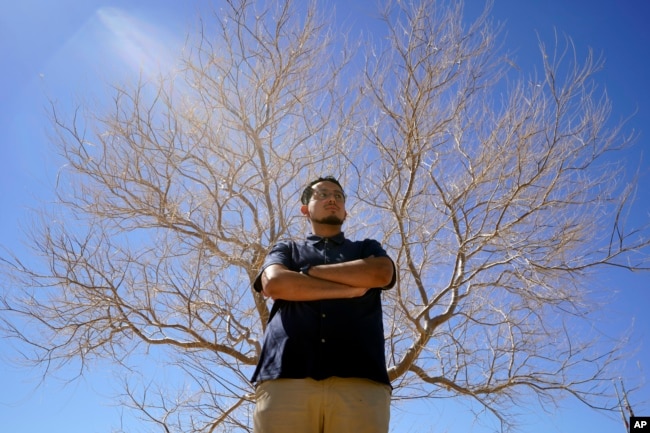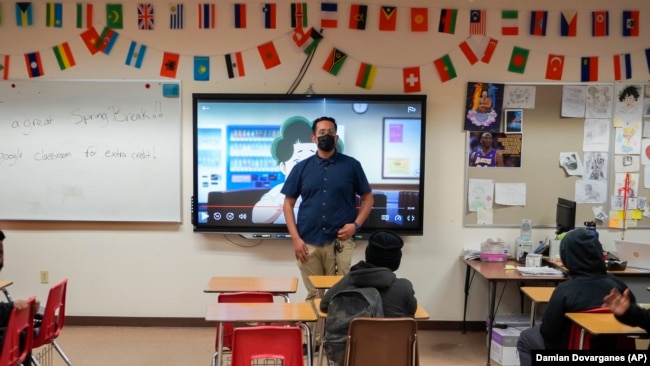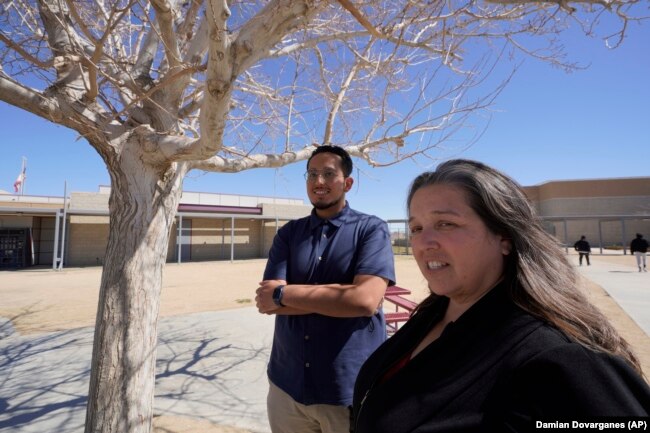メンタルヘルスケアー研修
私もこの研修受けたいです。対人関係構築に役立ちそう。
そして、私もカウンセリングを受けたいです。小中学生のころ、一時自殺願望がありました。空を見ては涙が溢れて、、、、手首に・・・・
でも今こうして生きています。でも、孤独って深い闇、おわりの見えないトンネル。
こういう先生に会えた生徒は幸せですね♬♡
VOAで英語を学びましょう!!
頬を流れる風に優しさを感じ、溢れる緑や花々に愛をもらい、川面に集う鳥たちに心を癒され、海に注ぐ水滴にありったけの思いを流して・・・
パンデミックが始まって以来、専門家はアメリカの子供たちが直面している精神衛生上の危機を警告してきました。それが今、うつ病、不安神経症、摂食障害、ケンカ、自殺思考の増加という形で起きているのです。
昨年12月、米国外科医長ヴィヴェック・マーシー氏は、"国家の若者の精神衛生の危機に対処することが緊急に必要である "と話しました。
同氏によると、2021年初頭、米国では自殺未遂の疑いによる緊急治療室の受診が、2019年の同時期と比較して、10代の女子で51、10代の男子で4%高かったと言います。
シャロン・フーバー氏は、メリーランド大学の教授で、国立学校精神保健センターの共同ディレクターを務めています。彼女は、パンデミック時に児童虐待やネグレクトが増加したと述べています。
テクノロジーや良好なインターネット接続がない生徒は、他の生徒よりも孤立していた。勉強も社会生活も遅れをとってしまったのです。そして、学校に戻ることが不安を増大させる子供もいました。
「『「よし、学校に戻ったぞ、数ヶ月経ったし、これでみんな元通りになるはずだ 』と思い込むことはできない(できない)のです。そうではないのです。」とフーバー氏は言います。
明るい兆し--悪い状況から良い方向に向かうという意味--は、教師のための特別なメンタルヘルス・トレーニングです。
このトレーニングは、教師が子供の精神的な健康リスクや薬物乱用の警告サインを知り、悲劇を防ぐ方法を学ぶのに役立ちます。このプログラムはNational Council for Mental Wellbeingによって運営されており、全米のすべての州で受けることができます。
カリフォルニアのある先生
研修を受ける教師の一人が、ベニート・ルナ・エレラ氏だ。カリフォルニア州ロサンゼルスから車で2時間のモハーベ砂漠の高貧困地域で、7年生の社会科を担当しています。
研修からわずか2週間後、彼はある生徒が当時のボーイフレンドとネット上で口論しているのを目撃しました。
「大丈夫?」と彼は声をかけました。その子は少しずつ、友人やボーイフレンド、家庭での問題をルナ・エレラ氏に話してくれました。彼女は孤独を感じていると言います。12歳の少女は、自傷行為を考えたことがあるとルナ・ヘレラ氏に話しました。
訓練では、そのような危機にどう対処すればよいかを教えます:警報を鳴らす。専門家の助けを借りる。自殺を考えている人を一人にしない。
ルナ・エレラ氏は少女と話を続けながら、学校関係者にメールを送りました。学校関係者は緊急連絡先に電話をかけ、警察が少女の家に駆けつけました。警察は少女の母親と話しましたが、母親は娘の自殺願望について驚いていました。
モハベ統一学校システムを率いるキャサリン・アギーレ氏は、「彼は絶対にその子の命を救ったのです。」と言いました。
研修のステップ
このトレーニングは、教師がプレッシャーに対処する通常の方法と、深刻な精神的苦痛の警告サインの違いを認識するのに役立ちます。これらの警告のサインは、明確な場合もあれば、隠されている場合もあります。
例えば、死や自殺について話すことが警告のサインになります。しかし、「もうこれ以上できない」、「もう疲れた」と言うのも警告になりえます。
行動の変化は、心配の種になりえます。例えば、次のような場合、教師は心配になるかもしれません。
●大好きな遊びをやめ、他の遊びをしなくなった。
●普段は整理整頓されているのにだらしなく見えるようになった
●成績が下がったり、課題を終わらせなくなったりする
●毎日一人で弁当を食べる
●友達と一緒に過ごさなくなる
何かおかしいかもしれないと思った後、研修では次のステップを教えます:プレッシャーや決めつけなしに、その生徒の状況を聞く;あなたが気にかけていることを彼らに知らせよう;あなたが助けたいとおもっていることを彼らに伝えよう。
このトレーニングでは、大人が自由回答式の質問をすることを教えています。この質問には、単純な はい いいえ の答えだけではありません。目標は、子供が話し続けることです。
大人は問題の重要性を認識し、「大丈夫だよ 。」とか 「そんなにひどくないよ 。」などと言わないようにすることが大切です。また、「私もそうだった 。」などと、子どもの問題に自分から首を突っ込まないようにすることも大切です。
Teachers Get Mental Health Training, Help Students
Since the pandemic started, experts have warned of a mental health crisis facing American children. That is now happening in the form of increased depression, anxiety, eating disorders, fights, and thoughts of suicide.
Last December, U.S. Surgeon General Vivek Murthy spoke about “the urgent need to address the nation’s youth mental health crisis.”
He said that in early 2021, emergency room visits in the U.S. for suspected suicide attempts were 51 percent higher for teenage girls and 4 percent higher for teenage boys compared to the same period in 2019.
Sharon Hoover is a professor and co-director of the National Center for School Mental Health at the University of Maryland. She said child abuse and neglect increased during the pandemic.
Students who lacked technology or good internet connections were isolated more than others. They fell behind in their studies and socially. And returning to school increased the anxiety of some children.
“We cannot (can’t) assume that ‘OK we’re back in school, it’s been a few months and now everyone should be back to normal.’ That is not the case,” said Hoover.
The silver lining -- which means a good thing to come from a bad situation -- is special mental health training for teachers.
This training helps teachers learn warning signs of mental health risks and substance abuse in children, and how to prevent a tragedy. The program is run by the National Council for Mental Wellbeing and is available in every state in the U.S.
One California teacher
One teacher taking the training is Benito Luna-Herrera. He teaches seventh-grade social studies in a high-poverty area of the Mojave Desert, a two-hour drive from Los Angeles, California.
Just two weeks after the training, he saw a student arguing online with her then-boyfriend.
“I asked her if she was OK,” he said. Little by little, the girl told Luna-Herrera about problems with friends, her boyfriend, and at home. She said she felt alone. The 12-year-old told Luna-Herrera she had considered hurting herself.
The training taught him how to handle such a crisis: Raise the alarm. Get expert help. Do not leave a person thinking about suicide alone.
As Luna-Herrera continued talking to the girl, he texted school officials. They called an emergency number sending police to the girl’s home. The police spoke with her mother, who was surprised about her daughter’s suicidal thoughts.
Katherine Aguirre who leads the Mojave Unified school system said, “He absolutely saved that child’s life.”
Steps in the training
The training helps teachers recognize the difference between normal ways of dealing with pressure and warning signs of serious mental suffering. Those warning signs can be clear, or they can be hidden.
For example, warning signs include talking about death or suicide. But saying, “I can’t do this anymore,” or “I’m tired of this,” could be warnings, too.
Changes in behavior could be cause for concern. For example, a teacher might be concerned if a child:
- stops an activity they loved without replacing it with another
- is usually tidy but starts looking untidy
- has falling grades or stops completing assignments
- eats lunch alone every day
- stops spending time with friends
After seeing that something might be wrong, the training teaches the next steps: Ask the student about their situation without pressure or judgment; let them know you care; let them know you want to help.
The training tells adults to ask open-ended questions. These questions need more than simple yes or no answers. The goal is to keep the child talking.
The adults are advised to see the importance of the problem and avoid saying, “You’ll be fine,” or “It’s not that bad.” They are also advised to not put themselves into a child’s problems with comments such as, “I went through that, too.”
Words in This Story
anxiety – n. a feeling of worry, nervousness, or unease, typically about an imminent event or something with an uncertain outcome.
address – v. to deal with : give attention to
teenage (teenaged) – adj. a young person aged 12 - 19
isolated – adj. occurring alone or once
assume – v. to accept as true
grade – n. a division of a school course representing a year's work
alarm – v. to give warning to : – n. a warning notice
tidy – adj. neat and orderly in appearance or habits; well ordered and cared for


